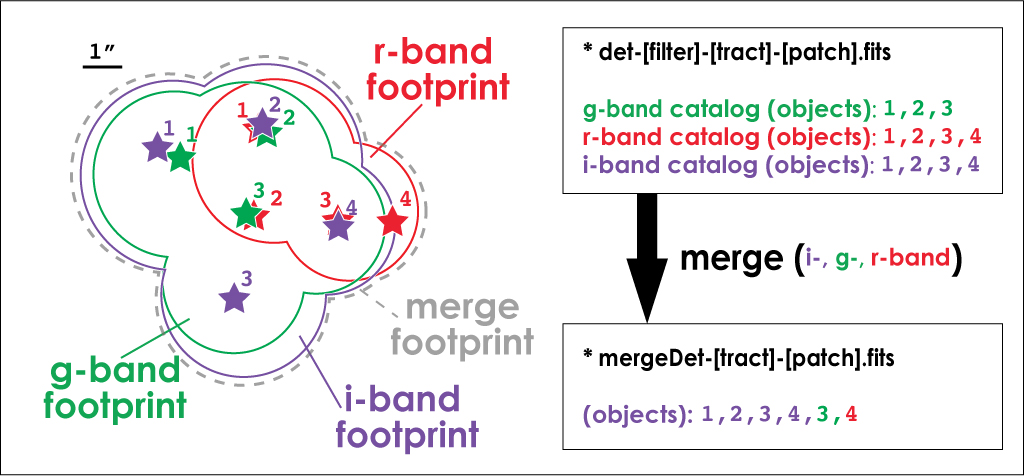Description of multiBandDriver.py¶
multiBandDriver.py can create multi-color catalog based on the detected object file generated by coaddDriver.py (figure 1). In this section, we describe the processing of multiBandDriver.py step by step.
1. Combining object catalogs in each filter (merge)¶
coaddDriver.py generates a detected object catalog for each filter (det-[filter]-[tract]-[patch].fits). First, multiBandDriver.py collect them and make new catalog (mergeDet-[tract]-[patch].fits).
The object list in mergeDet catalog is updated with the following priority;
(Here multiBandDriver.py refers filters as filter=[filter1^filter2^^filter3…])
- Register objects which are detected in the first reference filter (filter1).
- If an object in the second reference filter (filter2) is within 0”.3 of the peak of footprint of an object in filter1, they are regarded as the same object. If their separation is larger than 1”.0, it is regarded as a different object and registered as a new object.
- Register objects which are not detected on filter1 but on filter2.
- If an object in the third reference filter (filter3) is within 0”.3 of the peak of footprint of an object in filter2, they are regarded as the same object. If their separation is larger than 1”.0, it is regarded as a different object and registered as a new object.
- Register objects only detected in filter3.
For example, the footprint and peaks shown in Fig. 2 are identified in each filter. The objects (g: r: i) = (1,2,3: 1,2,3,4: 1,2,3,4) are detected and listed on the det catalog for each filter. Now we assume that the order of reference filter is from i-, g-, to r-band. In mergeDet catalog, all detected objects in i-band are listed (i-band 1,2,3, and 4). If the distance of peaks between i-band object and the one in another filter is within 0”.3, these two objects are the same, so the object detected in the another filter is not added to mergeDet catalog. In case of figure 2, (i-band 1/g-band 1), (i-band 2/g-band 2), and (r-band 1/i-band 4/r-band 3) are the same. Then the objects detected only in g-band are added. Object g-band 3 is considered to be the same as r-band 2. Finally the objects detected only on r-band (r-band 4) are added. The final mergeDet catalog holds the objects i-band 1, 2, 3, 4, g-band 3, r-band 4 and their photometric parameters.
Detected footprints in each filter are also collected into mergeDet catalog. The footprint in mergeDet catalog is determined as combined (merged) one for all filters. In case of figure 2, the footprint for mergeDet catalog is shown by grey dotted line.
2. Photometry using mergeDet catalog (meas)¶
Next, photometry is performed again using positional information listed in mergeDet catalog. The photometry is performed in each filter independently. The catalogs named meas-[filter]-[tract]-[patch].fits are created.
3. Making whole object catalog based on meas catalogs (ref)¶
In this step, the processing determined a reference band (ref-[tract]-[patch].fits) from meas catalogs in each filter. In this process, the contents of meas catalogs of reference filter for each objects are gathered and summarized. Then the reference band is defined from the result of meas considering the same priority in merge process.
4. Generate final catalogs for each filter (forced_src)¶
Finally, we generate catalogs for each filter based on ref catalog parameters (forced_src-[filter]-[tract]-[patch].fits). At this step, the photometry is performed in “forced mode”; the position and shape parameters are fixed to the values of reference band. If the parameters in meas catalog of the first reference filter are not changed during creating ref catalog, the results of photometry is almost same between meas and forced_src catalog of the first reference filter.
Contents of catalog and order of filter priority¶
The parameters of mergeDet catalog objects vary greatly depending on the order of referring filters. In case of figure 2, if the reference starts from r-, g-, to i-band, objects and photometry parameters for r-band 1, 2, 3, 4, g-band 1, and i-band 3 are added to mergeDet catalog.


